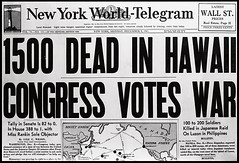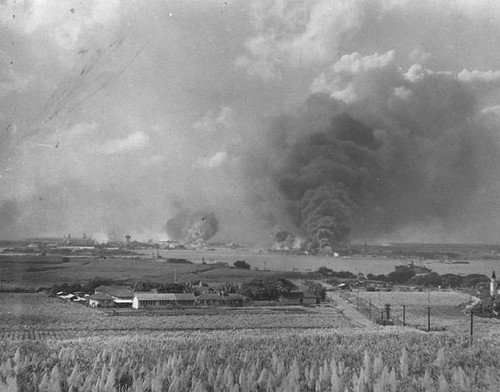 Every 7th of December I try to think about the Japanese attack on Pearl Harbor, but I’m not sure why I feel I have to. Oh, it’s an important date, all right, and though I’m far too young to have been there I have some personal memories and associations with the attack … but still, shouldn’t Americans pay more attention to the 2nd of September, VJ Day? Or how about the 18th of April? Now there’s a day to celebrate, because on that date in 1942, just four months and eleven days after Pearl Harbor, 80 brave American airmen launched their B-25 bombers off the USS Hornet and bombed targets in Tokyo, Yokohama, Yokosuka, Nagoya, and Kobe. The 7th of December, important though it may be, was not a shining moment for the USA. In spite of that, of all the key dates of World War II in the Pacific it’s the one we make the most fuss over. Go figure.
Every 7th of December I try to think about the Japanese attack on Pearl Harbor, but I’m not sure why I feel I have to. Oh, it’s an important date, all right, and though I’m far too young to have been there I have some personal memories and associations with the attack … but still, shouldn’t Americans pay more attention to the 2nd of September, VJ Day? Or how about the 18th of April? Now there’s a day to celebrate, because on that date in 1942, just four months and eleven days after Pearl Harbor, 80 brave American airmen launched their B-25 bombers off the USS Hornet and bombed targets in Tokyo, Yokohama, Yokosuka, Nagoya, and Kobe. The 7th of December, important though it may be, was not a shining moment for the USA. In spite of that, of all the key dates of World War II in the Pacific it’s the one we make the most fuss over. Go figure.
I have two Pearl Harbor stories for you today, both from my own experiences more than half a century later.
From 1992 to 1995 I was chief of flight safety for Pacific Air Forces, the major command that oversees our USAF bases, personnel, and operations in the Pacific theater, from Alaska to Korea to Japan to Guam to various small detachments in such places as Singapore and Australia. My office was in the PACAF headquarters building on Hickam AFB in Honolulu. On December 7, 1941, that building was a barracks, one of many on Hickam Field to be attacked and heavily damaged. Rather than tear it down we kept right on using it, bullet holes and all. Today it’s a living and working memorial to the attack.

The corner office in the photo belongs to the four-star general who commands PACAF. In this building, bullet holes equal prestige. I’m proud to say that though my office was on the second floor of the building’s opposite corner, the metal staircase leading up to it sported a 20mm hole.
Seven years ago, while working at Tucson’s VA hospital, I got to know an elderly patient. My new best friend, our dachshund Schatzi, had just come into my life, and I showed him a photo of her. It turned out he’d been a dachshund guy too, and he told me stories about driving across America with his last dachshund, Gretchen. One day, strapping his wheelchair down in the back of the van, I noticed a big old scar on his arm and asked him about it. “Oh, that’s from the attack,” he said. “Which one?” I asked. “Pearl Harbor,” he said. As I picked my jaw up off the floor he told me that story too.
He was a 17-year-old Marine medic at a temporary tent hospital in Aiea, up the side of the mountain looking down on Pearl Harbor, when the first wave of attacking Japanese planes hit. He and everyone else grabbed whatever medical supplies they could lay their hands on, jumped in their trucks and ambulances, and drove as fast as they could down the hill to Hickam Airfield and Pearl Harbor to help. During the second wave of the attack, as he was helping field dress another man’s wounds, a piece of scrapnel sliced through his right arm just above his wrist and he became a casualty himself.
Wow. And he never mentioned being a Pearl Harbor survivor until I asked him about it.
The first year we were in Hawaii, in 1992, we lived on the side of that same mountain in Aiea. It’s all houses now, but back then it was pineapple fields. I went looking for a photo and found this:

He’s gone now. I think they’re all gone … there are probably people still living who were children in Honolulu that day, but there can’t be too many of them either. Remember, remember … it’s the least we can do.